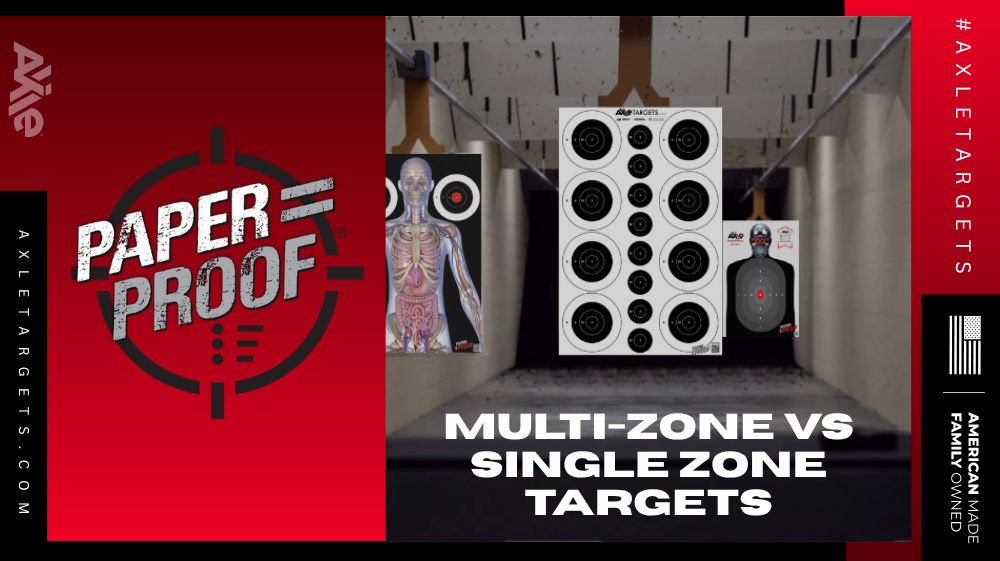In the world of firearms training, not all paper targets are created equal. Whether you're honing precision marksmanship or prepping for defensive shooting, the type of target you choose plays a major role in how effective your training session will be. The big question is: Are multi-zone targets actually better than the classic single bullseye?
Let’s break it down.
This guide compares multi-zone targets to single bullseye targets, outlines their pros and cons, explains which training scenarios benefit most from each, and features three top-tier paper targets from AxleTargets.com that will make your next range session more tactical, efficient, and fun.
🎯 What’s the Difference Between Multi-Zone and Single Bullseye Targets?
Before you start stacking holes in paper, it’s key to understand what separates these two popular target types.
Single Bullseye Targets
These are the classic paper targets we’ve all seen: a centered bullseye, often surrounded by concentric scoring rings. They’re built for precision and grouping, making them ideal for:
-
Zeroing optics and iron sights
-
Marksmanship drills
-
Competitive shooting
-
Slow-fire accuracy training
Think of it like a sniper’s test—one aimpoint, total focus.
Multi-Zone Targets
Now picture a target divided into multiple distinct zones or silhouettes, each representing different aim points. Multi-zone targets often mimic realistic scenarios, encouraging dynamic shot placement, target transitions, and decision-making.
Common use cases include:
-
Defensive shooting simulations
-
Rapid-fire drills
-
Transition practice (e.g. 2 to the body, 1 to the head)
-
Situational awareness training
Multi-zone targets force you to think, move, and react—not just aim.
⚖️ Pros and Cons of Each Target Type
Let's get tactical with a side-by-side comparison:
| Feature | Single Bullseye Targets | Multi-Zone Targets |
|---|---|---|
| Focus | Accuracy and precision | Speed, accuracy, and decision-making |
| Training Style | Stationary, controlled shooting | Dynamic, scenario-based shooting |
| Ideal For | Beginners, competitors, zeroing | Intermediate to advanced shooters |
| Versatility | Limited (one focal point) | High (multiple aim zones) |
| Engagement | Slower-paced | Fast-paced and reactive |
Multi-zone targets aren’t just “fancier”—they’re functionally more demanding. But that doesn’t mean bullseyes don’t have their place, especially for mastering the fundamentals.
🧠 When Should You Use Multi-Zone Targets?
Here’s where multi-zone targets shine:
1. Defensive and Tactical Training
If your goal is to prepare for real-life defense or tactical scenarios, single bullseyes just don’t cut it. Multi-zone targets train your brain and body to respond to variable threats.
Example: the Anatomy Target by Axle Targets features vital zone overlays of the human body—perfect for concealed carry practice, law enforcement drills, or home defense preparation.
2. Target Transition Drills
Ever tried “1 to 2, 2 to 3” drills? You need distinct zones to switch between—something a single bullseye can’t provide. Multi-zone targets push your peripheral vision and help improve acquisition speed and muzzle control.
3. Group or Partner Drills
Training with a buddy? Multi-zone layouts allow each shooter to focus on separate zones without swapping targets, saving time and adding pressure to hit your zone under stress.
🔥 Product Spotlights: Axle Targets That Train Smarter, Not Harder
Let’s spotlight three paper targets from AxleTargets.com that elevate your range days and directly align with multi-zone training benefits.
 |
1. B8 Cluster TargetWhy it's a must-have: Key Benefits:
Perfect For: Marksmanship practice, precision groups, recoil control. |
2. Anatomy TargetWhy it stands out: Key Benefits:
Perfect For: Tactical training, CCW holders, law enforcement. |
 |
 |
3. Terminator TargetWhy it’s tactical gold: Key Benefits:
Perfect For: Defensive drills, dynamic transitions, speed and accuracy work. |
💡 Expert Tips for Smarter Target Training
Let’s level up your next session with some quick tactical tips:
1. Start Slow, Then Build Speed
If you're new to multi-zone targets, start with deliberate, slow transitions. Speed comes later. Focus on control, accuracy, and consistency first.
2. Call Your Shots
Use multi-zone targets to call out specific zones before shooting. This reinforces muscle memory and decision-making under simulated stress.
"Zone 2, Zone 5, Zone 1—fire!"
3. Use a Shot Timer
Incorporating a shot timer can elevate your training with multi-zone targets. It creates real pressure, measuring draw speed, split times, and total engagement time.
4. Record and Review
Take photos of your targets post-session. This helps track progress and highlights patterns (like favoring a certain side or zone).
5. Mix Targets for Mixed Results
Try combining a bullseye target (like the B8 Cluster) with a multi-zone option (like the Terminator) in a single session. You’ll train both precision and performance—the best of both worlds.
🧭 Wrapping It Up: Which Target Type Should You Choose?
It’s not about which is “better.” It’s about which target serves your training goals.
-
If you’re a beginner, looking to sharpen accuracy and zero in? Start with single bullseyes.
-
If you’re ready to train like it’s real-world? Go with multi-zone targets that challenge your reaction time and judgment.
Axle Targets offers precision-cut, American-made paper targets that suit every skill level and range day objective. Whether you’re stacking tight groups or practicing body/head transitions under pressure, there's a perfect paper target for you.
👉 Explore Axle Targets’ full collection of paper targets and take your training to the next level.
✅ Quick Recap
-
Multi-zone targets offer dynamic, scenario-based shooting—great for tactical or defensive training.
-
Single bullseyes are ideal for developing tight groups and honing fundamentals.
-
Use both in your training for a balanced skillset.
-
Featured Axle Targets:

